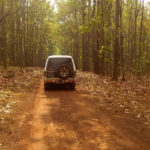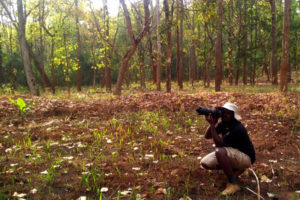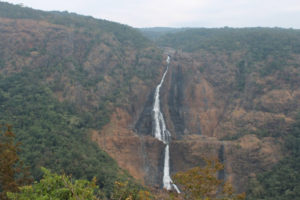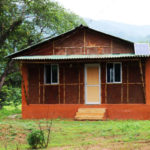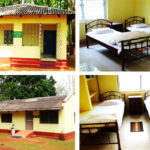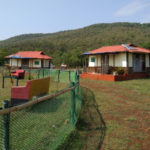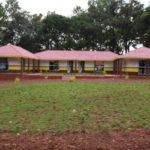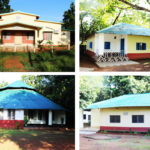Located at an average altitude of around 2880 feet above sea level and spread over 2750 sq. km. the Simlipal National Park is a tiger reserve in the Mayurbhanj district. It has been enlisted as a part of the UNESCO World Network of Biosphere Reserves since 2009. The word Similipal literally means “where red silk cotton trees grow” but it is not only a forest of Simul Trees but harbours about 1076 species of mammals, 231 species of birds, 29 types of reptiles and a very healthy collection of Orchids too. It is home to some beautiful waterfalls like Uski, Joranda and Barehipani Falls and several rivers like Khairi, Budhabalanga, Palpala, Salandi, Deo and few others, which originate from this forest and surrounding hills and creates a rich biodiversity. BOOKING DETAILS OF SIMLIPAL
Places to see at Similipal: There are few watch towers spread throughout the Simlipal Tiger Reserve and some stunning waterfalls like Beheripani, Uski and Joranda. Baherpani Waterfall has a drop of around 700 feet and is India’s Second Highest Waterfall. Joranda Waterfall is equally magnificient and has a drop of 590 feet. There are some scenic waterfalls like Jal Chitta, Asura Munda, Saona Gando, Bada Machhakandana and Sitakunda which are located within the Simlipal National Park but needs a few hours trek to reach.
For more photos of Simlipal click here |
Apart from these stunning Waterfalls and meandering rivers like Khairi and Palpala, Simlipal has an edaphic variation from dry deciduous to moist green forests and thus hosts some of the biggest Sal Trees as well as rare orchids. The entire Similipal region is undulating, rising from 2000 ft. above sea level to 4900 ft. above sea level. Two of the highest peaks of Odisha like Khairiburu (3840 ft.) and Meghasani (3750 ft.) falls within the National Park’s area too.
Nearby attractions of Simlipal: You can visit the The “Mugger Crocodile Management Programme” at Ramtirtha Village near Jashipur where the Mugger crocodile survives and flourishes. You can also visit the serene village of Bangriposhi near the Buribalam river and drive further to reach Thakurani Hill. You can reach the summit of the hill to see the temple of Goddess Bangriposi. Crossing this hill, you can visit the small marketplace of the tribal people. A few kilometers ahead is the Kuliyan village, which is renowned for Dokra artwork. You can also take a short trip to the Bankabal and Sulaipat Lake and their adjacent dams. You can also include Brahmakunda Waterfall and Kandia Luka Waterfall in your list of nearby attractions of Simlipal. Most of the tourists visiting Simlipal also keeps a night’s stay at Kuldiha Forest or Chandipur beach in their itinerary.
Things to do at Simlipal: Wildlife is abundant in Simlipal Tiger Reserve with a total of 42 species of mammals, 242 species of birds and 30 species of reptiles making it their home. The major mammals include the Bengal tiger, leopard, sambar, Asian elephant, barking deer, India Bison, jungle cat, wild boar, giant squirrel and common langur. Similipal is also a Bird Watcher and Bird Photographer’s paradise as it hosts 231 species of birds like Red jungle fowl, hill mynah, peafowl, Alexandrine parakeet, crested serpent eagle, grey hornbill, Indian pied hornbill, Malabar pied hornbill and Indian trogon are also found in the reserve.
How to reach Simlipal: There are two major major entry check posts at Simlipal Tiger Reserve – Pithabita near Baripada and Jashipur near Bangriposhi. The nearest major rail head is at Balasore and the nearest major Airport is at Kolkata (NSCBI). However, there are few trains to Baripada and Bangriposhi too.
Best time to visit Simlipal: Simlipal Tiger Reserve stays closed from June to September. During summers, the temperature is around 40 deg C whereas during the winter it falls to about 14 deg C. The monsoon season brings moderate to very heavy rainfall.
Lodging & Dining facilities at Simlipal: If you want to stay within the area of Simlipal National Park, then you can stay at Jamuani, Gurguria or Kumari. There is another accommodation option on the fringe of Simlipal at Ramtirtha. All accommodation options are quipped with standard facilities like attached western bathrooms, comfy beds, parking area, dining hall and others. The details are as follows:
JAMUANI: Located within the Forest Area, this eco resort has lush lawns, badminton courts, table tennis board, parking area and gardens. There are 04 non AC Double Bed tents, 09 non AC Double Bed Cottages and 01 non AC Four Bedded Bamboo Hut. Food is included in the Tariff and is served in the Dining Hall.
GURGURIA: Located within the Forest Area, this eco resort has an Orchid Center with a very impressive collection of indigenous Orchids which blooms during the summer. There are 04 non AC Double Bed Deluxe villa rooms, 02 non AC Double Bed Cottages and 01 non AC Double Bed Bamboo Hut. Food is included in the Tariff and is served in the Dining Hall.
KUMARI: Located within the Forest Area, this eco resort has 08 non AC Double Bed Cottages, 04 Non AC Double Bed Bamboo Cottages and 02 Non AC Machaan rooms. Food is included in the Tariff and is served in the Dining Hall.
BAREHIPANI: Located within the dense Sal Forest at Muktapur near Barehipani Waterfalls, this eco resort has 08 non AC Double Bed rooms in modern cottages. Food is included in the Tariff and is served in the Dining Hall.
RAMTIRTHA: The eco resort at Ramtirtha is located on the banks of River Bhandan and River Kahiri. The Crocodile Project and Nature Interpretation Center are located in an adjacent area of the eco resort. There are 04 AC Double Bed Deluxe Cottages, 03 AC Double Bed Tribal Cottages and 01 AC Ten Bedded Dormitory and 01 non AC Ten Bedded Dormitory. There is also an ancient Shiva Mandir located beside the river. Food is included in the Tariff and is served in the Dining Hall.

